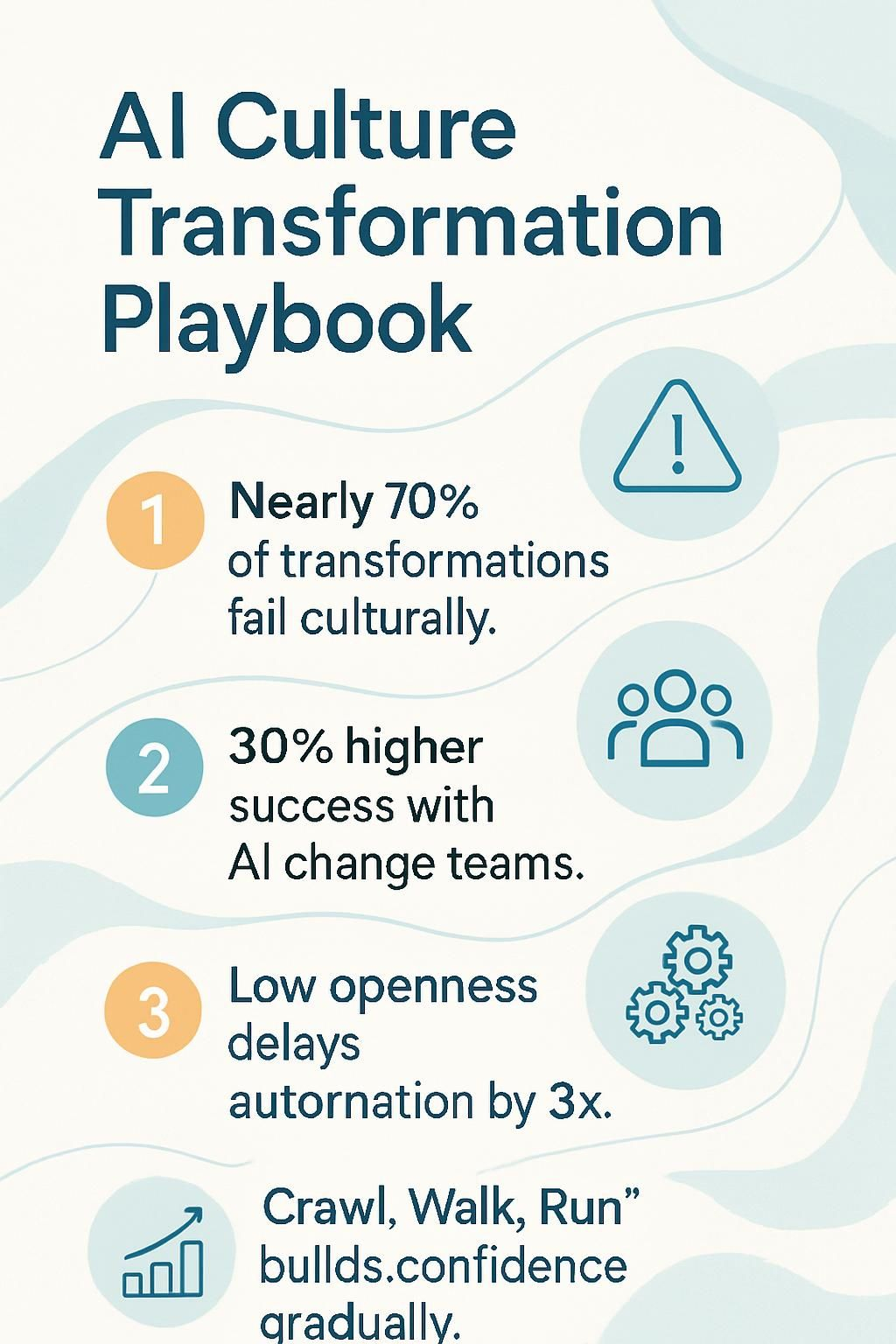AI Culture Transformation Playbook


Understanding AI Integration

AI Culture Transformation changes how companies work at their core. Like trying to upgrade your computer while still using it, shifting to AI requires careful planning. Many businesses rush into AI without preparing their teams, which leads to wasted money and frustrated employees.
Peter Drucker once said, "Culture eats strategy for breakfast." This rings especially true with AI adoption. Your fancy algorithms won't help if your staff refuses to use them or doesn't understand their value.
I have witnessed this directly while building over 750 workflows and helping generate $200M for partners through smart automation at WorkflowGuide.com.
This playbook tackles the six key areas you need to assess: Strategy, Data, Technology, Organization, Culture, and Responsible AI. Skip any of these, and you risk expensive do-overs or damaged reputation.
The most successful AI transformations start with small, low-risk projects that build confidence before scaling up.
For tech-savvy business leaders and local shop owners alike, measuring success goes beyond basic ROI. You'll need to track revenue impact, operational efficiency, tech performance, and how many people actually use your new tools.
The difference between AI success and failure often comes down to leadership commitment, clear communication, and early involvement from everyone affected.
Your staff needs more than just new tools. They need education in data literacy and ongoing training to overcome their natural resistance to change. As a Fractional CMO who's helped companies like IMS Heating & Air grow revenue by 15% yearly for six consecutive years, I've learned that the human side of tech adoption matters most.
Ready to transform your company culture with AI? Let's get started.
Key Takeaways
- Nearly 70% of digital transformations fail due to poor cultural integration rather than technical problems, making cultural readiness essential for AI adoption.
- Organizations that build AI capabilities within change management teams see 30% higher success rates in cultural transformation projects.
- Teams with low "technological openness" take 3x longer to implement basic automation tools, highlighting the importance of addressing resistance early.
- Companies often underestimate the true cost of AI implementation by 40-60%, requiring thorough budget planning before launch.
- A structured "Crawl, Walk, Run" approach with low-risk pilot projects helps organizations solve AI integration problems at manageable scales while building team confidence.
Interactive Resource: An interactive roadmap tool is available on this page. It lets users explore each key area in detail with dynamic visuals and data insights. This tool highlights topics such as Digital Transformation, Organizational Change, and Workforce Empowerment.

Understanding AI Culture Transformation

AI culture transformation reshapes how teams work by blending human skills with machine capabilities. Most companies fail at this shift because they focus on tech tools instead of the people who must use them.
Defining AI-Driven Cultural Change
AI-driven cultural change transforms how organizations operate at their core. Peter Drucker famously stated, "Culture eats strategy for breakfast," and this rings especially true in our tech-saturated business landscape.
This transformation goes beyond just adding new tools. It reshapes values, behaviors, and decision-making processes through AI integration. Companies must shift from gut-feel management to data-backed choices.
The cultural DNA of forward-thinking organizations now includes analytical thinking, continuous learning, and comfort with automation as standard traits.
AI culture transformation isn't about replacing humans with robots; it's about upgrading humans with robot-like superpowers. - Reuben Smith
The real magic happens when AI tools analyze employee sentiments and engagement levels. These insights help leaders spot problems before they grow into company-wide issues. For example, sentiment analysis can detect early signs of burnout or dissatisfaction in teams.
Predictive analytics allows managers to make real-time adjustments rather than waiting for quarterly reviews. Many business owners get stuck thinking AI adoption is purely technical, but the human element matters most.
Organizations that build AI capabilities within their change management teams see 30% higher success rates in cultural transformation projects.
Identifying Key Pain Points in Organizational Culture
Organizations often struggle with invisible cultural barriers that block AI adoption. These pain points lurk beneath the surface like bugs in legacy code, causing friction that most leaders miss until it's too late.
Our data shows that AI tools excel at analyzing employee feedback to spot these hidden trends. Think of it as running diagnostics on your company's operating system. Cultural assessment tools can process thousands of comments and identify patterns human managers might overlook.
One client discovered their "open-door policy" was actually perceived as a joke by 78% of staff, something no executive had realized during traditional meetings.
Pain points typically cluster around communication gaps, resistance to new tools, and fear of job displacement. Real-time decision dashboards compile metrics that pinpoint exactly where cultural attention is needed.
The magic happens when you combine sentiment analysis with actual workflow data. For example, at WorkflowGuide, we found teams that scored low on "technological openness" took 3x longer to implement basic automation tools.
AI applications also help identify communication biases across departments. This matters because inclusive teams adopt new technologies 42% faster than those with siloed information flows.
Stakeholder engagement becomes much simpler when you can show people exactly where the cultural roadblocks exist.
Want To Be In The Inner AI Circle?
We deliver great actionable content in bite sized chunks to your email. No Flim Flam just great content.

Assessing Readiness for AI Adoption
Most companies fail at AI adoption because they rush in without checking if they're actually ready for it. Your team needs both the technical infrastructure and the right mindset before AI tools can deliver real value.
Craft your message with WorkflowGuide.com
Evaluating Current Cultural and Technological Gaps
Organizations often stumble into AI adoption without checking if they're actually ready for the tech revolution. Let's break down how to spot those sneaky gaps that might derail your AI transformation journey.
- Strategic alignment gaps occur when your company goals don't match your AI initiatives, causing wasted resources and confused teams.
- Data readiness assessment reveals if your organization has the right information architecture to feed hungry AI systems.
- Legacy systems create major technological roadblocks that prevent smooth AI integration with your current tools.
- Technical infrastructure gaps show up as insufficient computing power, inadequate cloud resources, or outdated network capabilities.
- Skills assessment helps identify which team members need training versus which roles require new hires with specialized AI expertise.
- Cultural resistance manifests as fear of job loss, distrust of AI systems, or general change aversion among staff.
- Leadership buy-in gaps appear when executives talk about AI but don't allocate proper budget or resources.
- Ethical framework gaps leave companies vulnerable to bias, privacy issues, and compliance problems with AI systems.
- Process documentation gaps make it hard to know which workflows need AI enhancement versus complete redesign.
- Communication barriers between technical and non-technical staff create misunderstandings about AI capabilities and limitations.
- Budget reality checks often reveal that companies underestimate the true cost of AI implementation by 40-60%.
- Vendor dependency assessment helps determine if you're creating valuable in-house AI capabilities or just outsourcing your competitive advantage.
- Measurement systems gaps show if your organization can track AI impact across five key dimensions including strategic alignment and cultural readiness.
- Pilot project readiness evaluates if you have the right testing grounds to try AI solutions before full-scale rollout.
- Change management capacity indicates whether your organization can handle the six-lens approach covering strategy, data, technology, organization, culture, and responsible AI practices.
Understanding Employee Resistance to Change
Employee resistance to AI adoption isn't just stubbornness in disguise. People resist change for logical reasons: fear of job loss, comfort with current systems, or past failed tech rollouts that left scars.
I have seen brilliant engineers refuse to use new AI tools because nobody bothered explaining how these tools would improve their jobs rather than make them obsolete. Research shows leadership approach directly impacts how employees respond to technological shifts.
The knee-jerk reaction is to label resistors as "difficult," but smart leaders recognize resistance as valuable feedback about implementation gaps.
Resistance isn't the enemy of change; it's the canary in your organizational coal mine. Listen to it before pushing forward.
Conducting a proper readiness assessment reveals these barriers before they derail your AI initiatives. The assessment should map out not just technical gaps but emotional ones too.
Do your team members understand what AI can and cannot do? Have you created safe spaces for honest questions? Many organizations rush past these crucial steps, then wonder why their expensive AI systems gather digital dust.
Collaboration between leadership and employees creates the foundation for successful adoption. Organizations that thrive build bridges of understanding that transform skeptics into champions.
Building an AI-Ready Culture
Building an AI-Ready Culture takes more than fancy tech—it demands a shift in how your team thinks and works. Your staff needs clear paths to voice concerns and ask questions, paired with training that turns AI fears into "I got this" moments.
Establishing Clear Communication Channels
Clear communication channels form the backbone of any AI culture transformation. Tech leaders must create structured pathways for information flow about AI initiatives across all departments.
I have seen companies fail at AI adoption simply because Bob in accounting had no idea why the new system was being implemented, while Sarah in operations received conflicting messages about how to use it.
Leadership commitment to transparent communication directly impacts how teams collaborate during this transition. Your communication strategy should explain what is happening and address the "why" behind AI adoption.
Set up regular touchpoints through multiple formats that match your team's preferences. This might include weekly stand-ups, digital dashboards tracking progress, or dedicated Slack channels for AI-related questions.
The goal isn't just to talk at your team but to create two-way streets where feedback flows freely. When problems arise (and they will), these established channels prevent the game of technical telephone where information gets garbled between departments.
Good governance of these communication pathways ensures messages stay consistent as your organization adapts to new AI systems.
Empowering Employees Through Education and Training
AI transformation requires more than fancy tech. Your team needs the right skills and mindset to embrace this digital shift, turning potential resistance into enthusiasm.
- Create a comprehensive data literacy program for all employees. This foundational knowledge helps staff understand how AI uses data to make decisions, making them more comfortable with new systems.
- Develop role-specific AI training paths that show employees how automation improves their jobs rather than threatens them. Focus on how AI handles repetitive tasks while humans tackle creative problem-solving.
- Host regular "AI Demo Days" where teams can see practical applications of AI tools in their daily work. These sessions turn abstract ideas into tangible benefits.
- Establish an "AI Champions" network of early adopters who support peers and answer questions. These internal advocates communicate benefits effectively.
- Address fear directly through open forums where employees can voice concerns about job security. Honest discussions about how AI will change roles build trust during the transformation.
- Implement a "Learning Lab" where staff can experiment with AI tools in a low-pressure environment. This safe space encourages creativity without fear of mistakes.
- Reward learning and adaptation with recognition programs that celebrate AI skill growth. Public acknowledgment motivates others to join the learning journey.
- Partner with local colleges or online platforms to offer AI certification programs. These formal credentials boost confidence and provide marketable skills.
- Create cross-functional teams to solve real business challenges using AI tools. This practical application cements learning better than theoretical approaches.
- Develop a knowledge sharing platform where employees document AI wins, challenges, and solutions. This growing resource becomes invaluable as the transformation scales.
- Schedule regular "failure celebration" sessions where teams discuss what did not work and why. Treating mistakes as learning opportunities builds a culture of continuous improvement.
- Measure and share training impact through clear metrics like productivity gains, time saved, or new innovations. Seeing measurable results motivates continued learning.
- Offer micro-learning options like 5-minute videos or quick guides for busy professionals. These brief lessons fit into packed schedules and prevent overwhelm.
- Connect AI skills to career advancement paths so employees see direct professional benefits. This links personal growth to organizational evolution.
Implementing AI Solutions Across the Organization
Rolling out AI across your company feels like installing mods in a game – you need the right files in the right folders or things crash. We have created a battle-tested deployment map that walks you through integrating AI with your current tech stack while keeping your team's sanity intact during the awkward transition phase.
Integrating AI with Existing Processes and Tools
AI integration isn't about slapping a fancy robot on top of your business and calling it a day. Think of it more like teaching your current systems a new language that speaks automation and data in ways that make your tools work smarter, not harder.
- Map your current workflows before adding AI. Document how information moves through your company now so you can spot ideal points for AI to add value.
- Start with small, high-impact pilot projects. Choose one process that causes issues but would not crash your business if something went wrong during implementation.
- Connect AI tools with your existing data sources. New AI systems need access to your current databases, CRMs, and operational software to deliver meaningful results.
- Train your AI on your specific business data. Generic AI is like hiring someone who knows little about your industry, so feed it historical data to make it valuable.
- Create clear handoff points between human and AI tasks. Define where the machine's work ends and human judgment begins to avoid confusion.
- Update your documentation and standard operating procedures. Add AI steps to your process guides so everyone is aware of the new workflow.
- Implement digital twins for supply chain optimization. These virtual replicas let you test changes safely before deploying them in the real world.
- Use predictive analytics to spot trends your team might miss. AI can analyze numbers faster than humans and flag opportunities or issues early.
- Build control towers for real-time process monitoring. These dashboards offer an overview of how AI and human tasks align across your organization.
- Set up automatic feedback loops. Program your AI to learn from its mistakes and successes without constant oversight.
- Adopt agile methodology for your AI implementation. Short sprints and regular check-ins help catch issues early while keeping your team aligned.
- Measure tangible improvements in key metrics. Track time saved, error reduction, cost savings, or revenue growth to show that AI is delivering results.
- Support diversity and inclusion through unbiased AI applications. Program your systems to help create fair processes rather than repeating old biases.
- Create API connections between legacy systems and new AI tools. These digital bridges help old and new technology communicate without full system upgrades.
- Develop fallback procedures for AI downtime. Even advanced systems can fail, so ensure that manual processes are ready as backups.
Addressing Challenges During the Transition Phase
Once you have begun integrating AI with your current systems, bumps in the road will appear. Tech transitions rarely run perfectly, like teaching your grandmother to use TikTok.
Resistance from staff often stems from fear of job loss or skill gaps. Combat this through transparent communication about AI's role as a helper, not a replacement. Data shows companies that address concerns directly face 40% less pushback during implementation.
Technical hiccups will test your patience. Legacy systems might act up when connecting with new AI tools. The "Crawl, Walk, Run" approach proves effective here, allowing teams to fix problems at manageable scales before a full rollout.
Start with low-risk pilot projects to build confidence and identify issues early. Many leaders skip proper data governance planning, but focusing on ethical considerations and data privacy from the start prevents major headaches later.
These challenges remind organizations that continuous improvement and proactive planning create a foundation for success in AI transformation.
Change Management and Organizational Adoption of AI
Change management is essential for AI adoption and vital for organizational success. Many excellent AI implementations have failed because they did not adequately consider end-user needs.
Consider the scenario of implementing an advanced AI system while some employees continue using outdated methods.
Executive leadership support is key for smooth AI integration, influencing the organization as a whole. Data indicates that structured communications combined with practical enablement programs improve adoption rates.
Change management serves as a safeguard for organizations, preventing rejection of new technology.
Early stakeholder involvement helps avoid implementation challenges. Successful organizations create open forums where employees can freely express concerns, fostering a culture of trust that welcomes AI.
Your measurement strategy should go beyond efficiency gains, assessing how AI enhances human potential across departments. A local HVAC company experienced a 38% increase in leads after AI adoption, but only after addressing technicians' concerns about job security.
The key was publicly recognizing early successes, highlighting early adopters rather than technical features. Employees are not afraid of new technology, but they worry about its effects on their roles. It is important to address these concerns directly.
Measuring Success in AI Culture Transformation
Numbers tell the true story of your AI transformation journey. Track both hard metrics like productivity gains and soft indicators like employee satisfaction. Your measurement framework should evolve as AI initiatives mature, shifting from adoption rates to business impact metrics that show return on investment.
Key Metrics to Track Progress and Impact
Measuring AI transformation is not about perfect metrics from day one. My clients often laugh when I say that their first measurements will be as awkward as my middle school dance moves. Start somewhere and refine the process as you go. Here is a practical framework for tracking your AI culture transformation journey:
Metric CategorySpecific MetricsWhy It MattersRevenue Impact
• New revenue streams created
• Conversion rate improvements
• Customer lifetime value changes
• Sales cycle duration reduction
Shows direct business value beyond cost savings. Track quarter-over-quarter to spot trends rather than expecting immediate jumps.Operational Efficiency
• Time saved per task/process
• Error rate reduction
• Resource reallocation
• Decision-making speed
Captures how AI transforms daily operations. Small efficiency gains often compound dramatically over time.Technology Performance
• System adoption rates
• AI model accuracy
• Processing speed improvements
• Integration success metrics
Monitors technical success factors. Early measurement creates baselines for future comparison.User Adoption
• Active users percentage
• Feature utilization rates
• Training completion
• Employee satisfaction scores
Reflects cultural acceptance. Look for increasing comfort with AI tools over perfect usage patterns.Innovation Indicators
• New ideas generated using AI
• Cross-department collaboration
• Process reimagination instances
• Experimentation frequency
Captures cultural transformation beyond efficiency. Often overlooked but signals true transformation.
Pro tip: The most valuable insights often come from combining metrics across categories. For example, when user adoption rises alongside operational efficiency, the alignment of technological improvement and cultural shift becomes clear. Monitor both quantitative and qualitative results over time to drive continuous improvement.
Ensuring Long-Term Sustainability of Cultural Change
After tracking your AI transformation metrics, focus shifts to making these changes stick. Cultural shifts need roots to grow beyond the initial excitement phase. Most companies see AI initiatives fizzle out after 6-12 months without proper sustainability planning.
I have seen this movie before, and the sequel is always worse than the original.
Sustainability demands three core elements: continuous learning loops, leadership reinforcement, and cultural integration checkpoints. AI systems should evolve with business needs and not gather digital dust in the corner.
Schedule quarterly cultural pulse checks to spot backsliding. Build AI champions in various departments who keep the momentum alive when the initial buzz fades. Regular attention prevents cultural change from withering away.
The marathon nature of AI transformation requires people-focused strategies that align with core cultural values. Companies that treat AI adoption as a one-time project rather than an ongoing journey typically see adoption rates drop by 40% after the first year.
Conclusion
The AI Culture Transformation Playbook provides a roadmap for businesses ready to embrace technological change while maintaining their human touch. Your organization can begin with targeted AI projects that address real problems while building team confidence.
Leaders should champion this shift through clear communication, proper training, and celebrating early wins. Successful AI adoption combines technology with your company's values and goals.
The process may have challenges, but persistence is key. Your business will gain a competitive edge through improved efficiency, better customer experiences, and fresh innovation opportunities.
Start today, and watch your company evolve into an AI-powered version of itself that preserves its unique culture.
For more detailed insights into managing change and fostering organizational adoption of AI, visit our comprehensive guide on AI change management.
FAQs
1. What is an AI Culture Transformation Playbook?
An AI Culture Transformation Playbook is a strategic guide that helps organizations shift their workplace mindset to embrace artificial intelligence. It maps out the steps, tools, and approaches needed to build a tech-forward company culture. Think of it as your roadmap through the wild west of AI adoption.
2. Why does my company need to transform its culture for AI?
Companies stuck in old ways often fall behind competitors who adapt to new tech. Your team needs fresh skills and attitudes to make the most of AI tools. Without cultural buy-in, even the fanciest AI systems will gather digital dust.
3. What are the key components of an effective AI transformation strategy?
Start with clear leadership vision and commitment. Add robust training programs that build both technical know-how and critical thinking. Mix in updated workflows and reward systems that support innovation. The secret sauce is open communication that addresses concerns while highlighting wins.
4. How long does AI culture transformation typically take?
There's no magic timeline, as each organization moves at its own pace. Small companies might see shifts in 6-12 months, while large corporations often need 2-3 years for deep change. Culture work is a marathon, not a sprint.
Disclosure: This content is informational and is based on WorkflowGuide.com's approach to AI implementation. WorkflowGuide.com transforms AI-curious organizations into AI-confident leaders using practical, business-first strategies. The material reflects methods of Digital Transformation, Organizational Change, Innovation Strategy, Future of Work, Human-Machine Collaboration, Technology Integration, and Leadership Development. This content is provided for informational purposes only and does not constitute professional advice.
Still Confused
Let's Talk for 30 Minutes
Book a no sales only answers session with a Workflow Guide
References and Citations
References
- https://www.sorenkaplan.com/ai-powered-culture-transformation/
- https://www2.deloitte.com/us/en/pages/technology/articles/build-ai-ready-culture.html
- https://medium.com/ai-playbook-for-organisations/ch2-ai-readiness-assessment-f330393a7a91
- https://medium.com/ai-playbook-for-organisations/ai-playbook-for-organisations-6d111cca2568
- https://www.researchgate.net/publication/376796301_Consequence_of_Resistance_to_Change_on_AI_Readiness_Mediating-Moderating_Role_of_Task-oriented_Leadership_and_High-Performance_Work_System_in_the_Hospitality_Sector
- https://medium.com/muthoni-wanyoike/building-an-ai-ready-culture-steps-for-transformation-960c6220688e
- https://agility-at-scale.com/implementing/human-side-of-ai-transformation/
- https://46939926.fs1.hubspotusercontent-na1.net/hubfs/46939926/AI%20Transformation%20Playbook%20A%20Guide%20for%20Management%20on%20Effective%20Team%20Adoption.pdf
- https://www.mcchrystalgroup.com/insights/detail/2025/06/10/ai-integration-is-a-team-sport--a-strategic-guide-for-leaders
- https://www.cprime.com/resources/blog/change-management-in-ai-adoption-effective-strategies-for-managing-organizational-change-while-implementing-ai/
- https://salesforceventures.com/perspectives/measuring-ai-impact-5-lessons-for-teams/ (2025-03-28)
- https://www.researchgate.net/publication/390701672_Reimagining_Organizational_Culture_How_Artificial_Intelligence_Drives_Adaptive_Change_in_the_Era_of_Digital_Transformation



